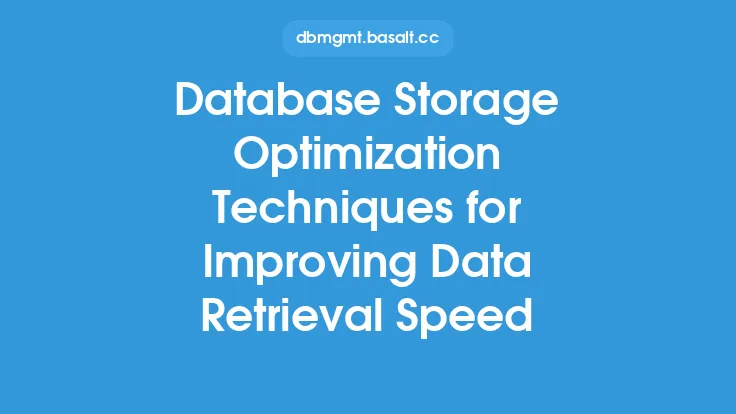When it comes to optimizing database performance, one of the most critical aspects to focus on is data retrieval efficiency. This is where indexing strategies come into play, as they enable databases to quickly locate and retrieve specific data, thereby improving overall performance. In this article, we will delve into the world of indexing strategies, exploring the various techniques and methods that can be employed to improve data retrieval efficiency.
Introduction to Indexing Strategies
Indexing strategies are designed to reduce the time it takes for a database to retrieve specific data. This is achieved by creating a data structure that facilitates quick lookup, thereby minimizing the need for the database to scan the entire dataset. Indexing strategies can be broadly categorized into two main types: clustering indexes and non-clustering indexes. Clustering indexes are used to store data in a specific order, making it easier to retrieve data that is physically close together. Non-clustering indexes, on the other hand, store data in a separate location, allowing for faster lookup and retrieval.
Types of Indexing Strategies
There are several types of indexing strategies that can be employed, each with its own strengths and weaknesses. Some of the most common types of indexing strategies include:
- B-Tree Indexing: This is one of the most commonly used indexing strategies, particularly in relational databases. B-Tree indexing uses a self-balancing search tree to store data, allowing for efficient insertion, deletion, and search operations.
- Hash Indexing: This type of indexing strategy uses a hash function to map keys to specific locations in a hash table. Hash indexing is particularly useful for equality searches, where the database needs to retrieve data that matches a specific value.
- Full-Text Indexing: This type of indexing strategy is used to index large amounts of unstructured data, such as text documents. Full-text indexing allows for efficient searching and retrieval of data based on specific keywords or phrases.
- Bitmap Indexing: This type of indexing strategy uses a bitmap to represent the presence or absence of a specific value in a column. Bitmap indexing is particularly useful for columns that contain a limited number of distinct values.
Indexing Strategy Selection
Selecting the right indexing strategy is critical to improving data retrieval efficiency. The choice of indexing strategy depends on several factors, including the type of data, the frequency of queries, and the available resources. Some of the key factors to consider when selecting an indexing strategy include:
- Data distribution: The distribution of data in the column or table can significantly impact the effectiveness of an indexing strategy. For example, a column with a large number of distinct values may benefit from a B-Tree index, while a column with a limited number of distinct values may benefit from a bitmap index.
- Query patterns: The type and frequency of queries can also impact the effectiveness of an indexing strategy. For example, a database that is frequently queried using a specific column may benefit from a hash index on that column.
- Resource availability: The available resources, such as disk space and CPU power, can also impact the choice of indexing strategy. For example, a database with limited disk space may benefit from a more compact indexing strategy, such as a bitmap index.
Indexing Strategy Maintenance
Indexing strategies require regular maintenance to ensure optimal performance. Some of the key maintenance tasks include:
- Index rebuilding: Over time, indexes can become fragmented, leading to decreased performance. Rebuilding indexes can help to restore performance and improve data retrieval efficiency.
- Index statistics: Index statistics, such as the number of rows and the distribution of data, can help to identify areas where indexing strategies can be improved.
- Query optimization: Query optimization techniques, such as rewriting queries and using index hints, can help to improve the effectiveness of indexing strategies.
Advanced Indexing Strategies
In addition to the basic indexing strategies, there are several advanced techniques that can be employed to further improve data retrieval efficiency. Some of these techniques include:
- Composite indexing: Composite indexing involves creating an index on multiple columns, allowing for more efficient retrieval of data that spans multiple columns.
- Function-based indexing: Function-based indexing involves creating an index on the result of a function, allowing for more efficient retrieval of data that is based on a specific calculation.
- Partitioning: Partitioning involves dividing a large table into smaller, more manageable pieces, allowing for more efficient retrieval of data and improved indexing strategy performance.
Best Practices for Implementing Indexing Strategies
When implementing indexing strategies, there are several best practices to keep in mind. Some of these best practices include:
- Monitor index performance: Regularly monitoring index performance can help to identify areas where indexing strategies can be improved.
- Test indexing strategies: Thoroughly testing indexing strategies can help to ensure that they are effective and efficient.
- Consider data distribution: Considering the distribution of data in the column or table can help to ensure that the chosen indexing strategy is effective.
- Avoid over-indexing: Avoiding over-indexing can help to prevent decreased performance and improved data retrieval efficiency.
Conclusion
In conclusion, indexing strategies play a critical role in improving data retrieval efficiency in databases. By understanding the different types of indexing strategies, selecting the right indexing strategy, and maintaining indexing strategies, database administrators can significantly improve the performance of their databases. Additionally, advanced indexing strategies and best practices can help to further optimize data retrieval efficiency, ensuring that databases are able to handle large amounts of data and complex queries with ease.





